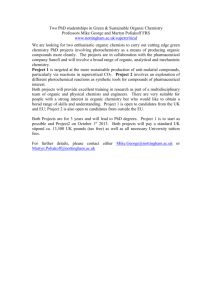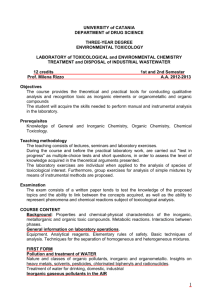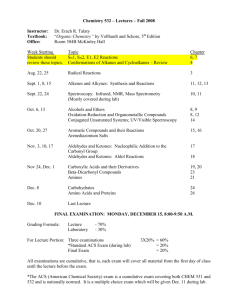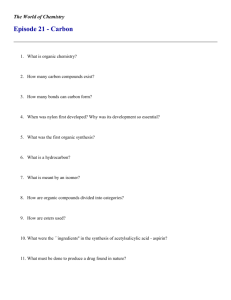02 organic and inorganic chemistry
advertisement
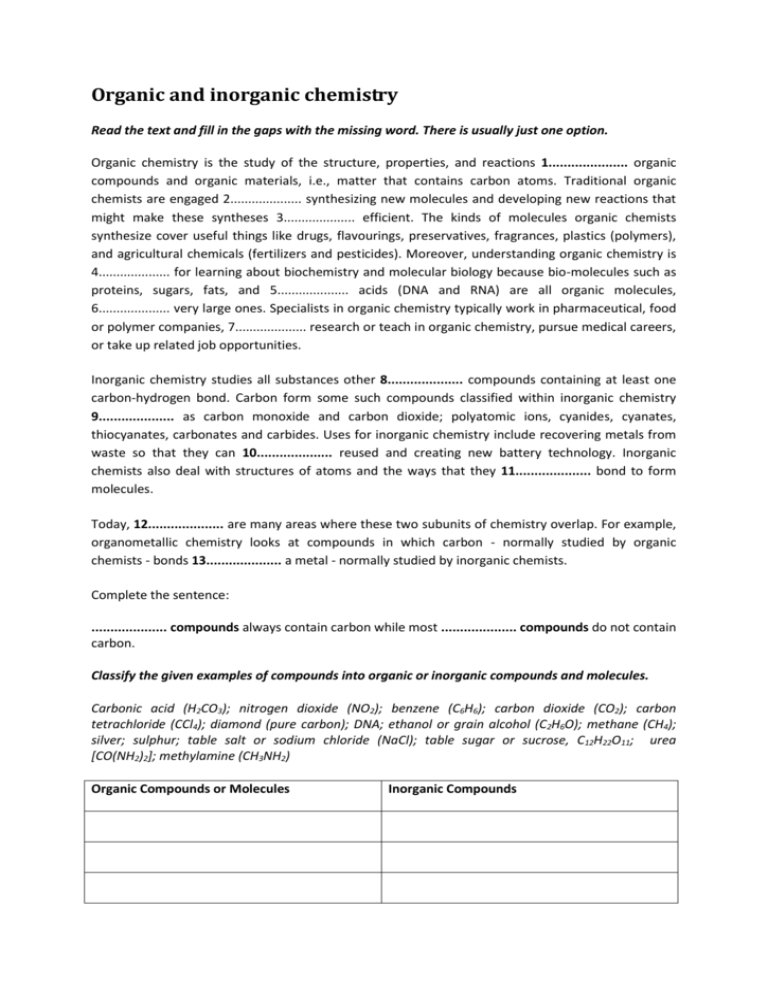
Organic and inorganic chemistry Read the text and fill in the gaps with the missing word. There is usually just one option. Organic chemistry is the study of the structure, properties, and reactions 1..................... organic compounds and organic materials, i.e., matter that contains carbon atoms. Traditional organic chemists are engaged 2.................... synthesizing new molecules and developing new reactions that might make these syntheses 3.................... efficient. The kinds of molecules organic chemists synthesize cover useful things like drugs, flavourings, preservatives, fragrances, plastics (polymers), and agricultural chemicals (fertilizers and pesticides). Moreover, understanding organic chemistry is 4.................... for learning about biochemistry and molecular biology because bio-molecules such as proteins, sugars, fats, and 5.................... acids (DNA and RNA) are all organic molecules, 6.................... very large ones. Specialists in organic chemistry typically work in pharmaceutical, food or polymer companies, 7.................... research or teach in organic chemistry, pursue medical careers, or take up related job opportunities. Inorganic chemistry studies all substances other 8.................... compounds containing at least one carbon-hydrogen bond. Carbon form some such compounds classified within inorganic chemistry 9.................... as carbon monoxide and carbon dioxide; polyatomic ions, cyanides, cyanates, thiocyanates, carbonates and carbides. Uses for inorganic chemistry include recovering metals from waste so that they can 10.................... reused and creating new battery technology. Inorganic chemists also deal with structures of atoms and the ways that they 11.................... bond to form molecules. Today, 12.................... are many areas where these two subunits of chemistry overlap. For example, organometallic chemistry looks at compounds in which carbon - normally studied by organic chemists - bonds 13.................... a metal - normally studied by inorganic chemists. Complete the sentence: .................... compounds always contain carbon while most .................... compounds do not contain carbon. Classify the given examples of compounds into organic or inorganic compounds and molecules. Carbonic acid (H2CO3); nitrogen dioxide (NO2); benzene (C6H6); carbon dioxide (CO2); carbon tetrachloride (CCl4); diamond (pure carbon); DNA; ethanol or grain alcohol (C2H6O); methane (CH4); silver; sulphur; table salt or sodium chloride (NaCl); table sugar or sucrose, C12H22O11; urea [CO(NH2)2]; methylamine (CH3NH2) Organic Compounds or Molecules Inorganic Compounds 10 Carbon Facts. (http://chemistry.about.com/od/elementfacts/a/carbonfacts.htm) One of the most important elements for all living things is carbon. Here are 10 interesting carbon facts for you. Match the parts of the sentences. 1. Carbon is the basic element in organic (diamond) or one of the softest (graphite). chemistry, 2. Carbon is a non-metal that can bond with chemical elements, forming nearly ten million itself and many other compounds. 3. Elemental carbon can take the form of one of the hardest substances countless uses. 4. All carbon was made inside stars, from the Latin word carbo, for charcoal. 5. Carbon allotropes (diamond, graphite or charcoal) have has been known since prehistoric time. 6. Carbon has the highest melting/sublimation in the universe (hydrogen, helium, and oxygen are found in higher amounts, by mass). 7. Pure carbon exists free in nature and particles, such as soot, can damage lung tissue. 8. The origin of the name 'carbon' is derived point of the elements. 9. Pure carbon is considered non-toxic, albeit inhaling fine since it is present in all living organisms. 10. Carbon is the fourth most common element though it was not produced in the Big Bang. Word search puzzle. Names and Formulas of Chemical Compounds. Can you find all 14 chemical compounds? The formulae next to the word search puzzle will help you. S M D B E X X M O J X J R M C L Z F K T I G R D T D V W L V R Q G U L Q E W N U P O T A S S I U M S U L F A T E Z H D J H B E D I X O R E P N E G O R D Y H T Z F I J L S Y C X O L T R E R I L N K E Y Q T R Q C J E A D L R C E C W D G U D P I I W Z S T T C L G H K A R S K M R R G F B S Q A C E T I C A C I D Q P H I F W C T V E M A G N E S I U M S U L F I D E I I O L D Z B T N R U U A U H E D Y X W N I O T N I T R O G E N M O N O X I D E D F U V N W X L Z W K D M I F I B I U G A E J Z G P H O O H N O O K O R M S N B O X W Y Z C G O M Q S J N P H D K U R C C A R B O N D I S U L F I D E B I M L H H Y D R O X I C A C I D A Q J Z N D Y A C O D R F O R M I C A C I D B C R H E W V Y E A Q H V K I I A W L U G L X L Q S H V P R G W I Z L E X E S A E F O G D V W P E H C V A D V Z R I R A C R K N M I CH₃COOH MgS AlCl₃ NO NH₃ O₃ CaI₂ K₂SO₄ CaO CS₂ HCOOH HCl H₂O₂ H₂O Translate the following phrases from chemistry. elektronová konfigurace uhlíku .................................................................... čtyřvazný uhlík .................................................................... jednoduchá, dvojná a násobná vazba .................................................................... nasycené a nenasycené sloučeniny .................................................................... uhlovodíky a jejich deriváty .................................................................... řetězec lineární, rozvětvený a uzavřený .................................................................... nesymetrické rozložení náboje .................................................................... atomy o různé elektronegativitě .................................................................... štěpení nepolární vazby .................................................................... vypočítat hmotnost uhlovodíků .................................................................... halogenové a sirné sloučeniny nekovů .................................................................... těkavé organické látky .................................................................... cyklické uspořádání vzájemně vázaných atomů .................................................................... chemicky čistá činidla .................................................................... substituenty připojené v cyklickém uspořádání .................................................................... Characteristic groups of organic compounds. Fill in the table with the names of compounds below. alcohols; aldehydes; amides; amines; carboxylic acid; ethers; halogen compounds; ketones; nitrides; phenols; thiols Compounds Characteristic groups — F, — Cl, — Br, — I — NH2, — NH — , — OH —O— — CHO — CO — — COOH — C≡N — CONH2, — CONH —, — SH Bonding. (https://www.youtube.com/watch?v=R0g-H1dcfnY). Pre- listening task. Read the following statements and decide whether they are true (T) or false (F). Then watch the video and check your answers. Atoms of metals are made up of a central nucleus (protons and neutrons cluster together) surrounded by electrons that are constantly orbiting. Non-metal atoms may gain electrons and become negatively charged. Ionic bonding is when positive and negative ions attract one another and bind together forming a new substance. Ionic compounds like magnesium oxide and sodium chloride have very low melting points so they conduct electricity when molten. A covalent bond forms when two non-metal atoms share a pair of electrons. The simplest hydrocarbon is methane. The carbon atom has six electrons, 2 of the electrons are in its valence shell. F -4 of them are in the outer shell. Vocabulary acetic acid (n) /əˌsiːtɪk ˈæsɪd/ kyselina octová agent (n) /ˈeɪdʒ(ə)nt/ činidlo albeit (conj) /ɔːlˈbiːɪt/ ačkoliv (form.) alcohols (n) /ˈælkəˌhɒls/ alkoholy aldehydes (n) /ˈældɪˌhaɪds/ aldehydy allotrope (n) /ˈæləˌtrəʊp/ alotrop aluminium chloride (n) /əˈluːmɪnəm ˈklɔːraɪd/ chlorid hlinitý amides (n) /ˈæmaɪd/ or /ˈæmɪd/ amidy amines (n) /əˈmiːns; ˈæmɪns/ aminy ammonia (n) /əˈməʊnɪə; -njə/ amoniak, čpavek calcium iodide (n) /ˈkælsɪəm ˈaɪəˌdaɪd/ jodid vápenatý calcium oxide (n) /ˈkælsɪəm ˈɒksaɪd/ oxid vápenatý carbide (n) /ˈkɑːbaɪd/ karbid carbon disulphide (n) /ˈkɑː(r)bən daɪˈsʌlfaɪd/ sulfid uhličitý, sirouhlík carbon tetrachloride (n) /ˈkɑː(r)bən ˌtɛtrəˈklɔːraɪd/ chlorid uhličitý carbonate (n) /ˈkɑːbəˌneɪt ; -nɪt/ uhličitan carboxylic acid (n) /ˌkɑːbɒkˈsɪlɪk ˈæsɪd/ karboxylová kyselina charcoal (n) /ˈtʃɑː(r)ˌkəʊl/ aktivní uhlí cleavage (n) /ˈkliːvɪdʒ/ štěpení configuration /kənˌfɪɡjəˈreɪʃ(ə)n/ konfigurace cyanide (n) /ˈsaɪəˌnaɪd/ kyanid diamond (n) /ˈdaɪəmənd/ diamant engage in (v) /ɪnˈɡeɪdʒ ɪn/ zabývat se ethanol (n) /ˈeθənɒl/ etanol ethers (n) /ˈiːθəs/ étery fertilizer (n) /ˈfɜː(r)təlaɪzə(r)/ hnojivo fine (adj) /faɪn/ drobný fission (n) /ˈfɪʃ(ə)n/ štěpení formic acid (n) /ˈfɔːmɪk ˈæsɪd/ kyselina mravenčí fragrance (n) /ˈfreɪɡrəns/ vůně (příjemná) grain alcohol (n) /ɡreɪn ˈælkəˌhɒl/ etanol graphite (n) /ˈɡræfaɪt/ grafit halogen (adj) /ˈhælədʒen/ halogenový halogen compound (n) /ˈhælədʒen ˈkɒmpaʊnd/ halogenová sloučenina hydrochloric acid (n) /ˌhaɪdrəˌklɒrɪk ˈæsɪd/ kyselina chlorovodíková hydrogen peroxide (n) /ˈhaɪdrədʒən pəˈrɒkˌsaɪd/ peroxid vodíku ion (n) /ˈaɪən/ iont ketones (n) /ˈkiːtəʊns/ ketony magnesium sulphide (n) /mæɡˈniːziəm ˈsʌlfaɪd/ sulfid hořečnatý mass (n) /mæs/ hmota; hmotnost matter (n) /ˈmætə(r)/ hmota; látka melt (v) /melt/ tát methane (n) /ˈmiːθeɪn/ metan methylamine (n) /miːˈθaɪləˌmiːn/ methylalamin nitrides (n) /ˈnaɪtraɪds/ nitridy nitrogen monoxide (n) /ˌnaɪtrədʒ(ə)n daɪˈɒksaɪd/ oxid dusnatý organometallic (adj) /ɔːˌɡænəʊmɪˈtælɪk/ organokovový ozone (n) /ˈəʊzəʊn/ ozon pesticide (n) /ˈpestɪsaɪd/ pesticid phenols (n) /ˈfiːnɒls/ fenoly potassium sulphate (n) /pəˈtæsiəm ˈsʌlfeɪt/ síran hořečnatý preservation (n) /ˌprezə(r)ˈveɪʃ(ə)n/ konzervace property (n) /ˈprɒpə(r)ti/ vlastnost reagent (n) /riˈeɪdʒ(ə)nt/ činidlo recover (v) (metals) /rɪˈkʌvə(r)/ opětovně získávat, recyklovat saturated (adj) /ˈsætʃəˌreɪtɪd/ nasycený sodium chloride (n) /ˈsəʊdiəm ˈklɔːraɪd/ chlorid sodný sublimation (n) /ˌsʌblɪˈmeɪʃ(ə)n/ sublimace; přeměna sucrose (n) /ˈsuːkrəʊs/ sacharóza sulphur (adj) /ˈsʌlfə(r)/ sirný synthesize (v) /ˈsɪnθəsaɪz/ sloučit; syntetizovat tetravalent (adj) /ˌtetrəˈveɪlənt/ čtyřvazný thiocyanate (n) /ˌθaɪəʊˈsaɪəˌneɪt/ thiokyanatan thiols (n) /ˈθaɪɒl/ tioly unsaturated (adj) /ʌnˈsætʃəˌreɪtɪd/ nenasycený volatile (aj) /ˈvɒlətaɪl/ těkavý

